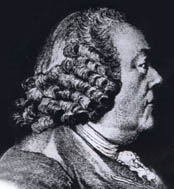- Gerard van Swieten
Infobox Scientist
name = Gerard van Swieten
box_width = 300px |300px
|300px
image_width = 300px
caption = Gerard van Swieten on the memorial to Maria Theresia, Vienna
birth_date =May 7 ,1700
birth_place =Leiden
death_date =June 18 ,1772
death_place =Vienna
residence = flag|Austria
citizenship =
nationality = flag|Netherlands
ethnicity =
field =Physician
work_institutions =University of Vienna
alma_mater =University of Vienna
doctoral_advisor =Hermann Boerhaave
doctoral_students =Anton von Störck
known_for = Debunking ghosts and vampires
author_abbrev_bot =
author_abbrev_zoo =
influences =
influenced =
prizes =
religion =
footnotes =Van Swietens career
Van Swieten was born in
Leiden . He was a pupil ofHermann Boerhaave and became in 1745 the personal physician of the Austrian EmpressMaria Theresa . In this position he implemented a transformation of the Austrian health service and medical university education. He founded a botanical garden, a chemical laboratory and introduced clinical instruction.Van Swietens part in the fight against superstition
Especially important is his part in the fight against
superstition during the enlightenment, particularly in the case of thevampyres , that were reported from villages inEastern Europe in the years between 1718 and 1732. After the last of the wars against the Turks in 1718 some parts of the land, e.g. Northern Serbia and a part of Bosnia, went to Austria. These parts were settled with refugees that had the special status of dutyfree farmers. But for that they had to take care of the agricultural development and secure the frontier. Because of that the reports about thevampyres reached for the first time German-speaking area. In the year 1755 Gerard van Swieten was sent by Empress Maria Theresa toMoravia to investigate the situation relating tovampires . He viewed the vampire myth as a "barbarism of ignorance" and his aim was to eradicate it.He investigated it very thoroughly, and wrote a rational report, "Abhandlung des Daseyns der Gespenster" (or "Discourse on the Existence of Ghosts"), in which he offered an entirely natural explanation for a belief in vampires. He explained the unusual states in the graves with possibles causes like processes of fermentation and lack of oxygen what was a reason for preventing decomposition. Characteristic for his opinion is this quotation from the preface to his essay of 1768: “… that all the fuss doesn't come from anything else than a vain fear, a superstitious credulity, a dark and eventful imagination, simplicity and ignorance among the people.” Some other
physicians supported his theory or even found out other reason for the frequent deaths in the villages, e.g. epidemics.Therefore Gerard van Swieten is one of the most important fighters against the
superstition of the “simple” people. Because of his report, Empress Maria Theresa enacted an edict about vampyres that prohibited all traditional processes such asimpalement ,beheading and burning of dead bodies.Reform
Beside his medical activities, Gerard van Swieten was also active as a
reformer . Especially thecensorship was organized in a different way under his direction. He drove out theJesuits that were in charge of the censorship before and carried out a centralization of the censorship that was only partly successful. He also tried to use scientific and rational aspects for the judgement of literature.Gerard van Swieten was the father of
Gottfried van Swieten who was later known as the patron ofWolfgang Amadeus Mozart . A genus ofmahogany was named after Gerard van Swieten, "Swietenia ", byNikolaus Joseph von Jacquin .ee also
Gerard van Swieten was recently selected as the main motif of an Austrian collectors' coin, the Gerard van Swieten commemorative coin, minted in
January 31 2007 . His legacy to the world of medicine made him the choice for the first coin in this new gold series “Celebrated Physicians of Austria”. The obverse side shows his portrait holding a book.The "Frank - van Swieten Lectures", an international course about strategic information management in hospitals that is organized by TU Braunschweig,
University of Amsterdam ,University of Heidelberg , UMIT at Hall near Innsbruck andFachhochschule Heilbronn is also named after him.References
* Hamberger, Klaus: Mortuus non mordet. Dokumente zum Vampirismus 1689-1791. Wien 1992
Wikimedia Foundation. 2010.
